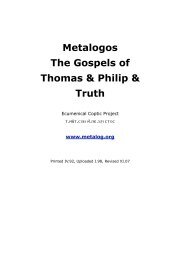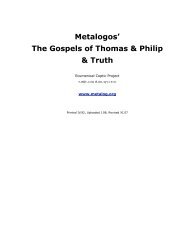Andrew Louth - Syriac Christian Church
Andrew Louth - Syriac Christian Church
Andrew Louth - Syriac Christian Church
You also want an ePaper? Increase the reach of your titles
YUMPU automatically turns print PDFs into web optimized ePapers that Google loves.
70 INTRODUCTION<br />
Difficulty 41 is built up around this notion of the divisions of being.<br />
According to the Saints, Maximus begins (an expression that always<br />
means that he in introducing a traditional notion, and often<br />
something that can be precisely paralleled in earlier Fathers, as here),<br />
there are five divisions of being. The first divides uncreated nature<br />
from that which is created. The second divides created being into that<br />
perceived by the mind and that perceived by the senses. The sensible<br />
realm is further divided into heaven and earth; earth into paradise<br />
and the inhabited world (what the Greeks called the<br />
oikoumenê). Within the inhabited world human beings dwell and<br />
these are divided by sex into male and female. But the human being is<br />
not just the last stage in this structure, it is, as he says, ‘the<br />
laboratory in which everything is concentrated and in itself naturally<br />
mediates between the extremities of each division’, for human beings<br />
are found on both sides of each division: they belong in paradise but<br />
inhabit the inhabited world; they are earthly and yet destined for<br />
heaven; they have both mind and senses; and though created, they are<br />
destined to share in the uncreated nature by deification. All the<br />
divisions of the cosmos are reflected in the human being, so the<br />
human being is a microcosm, a ‘little cosmos’ (a term Maximus does<br />
not use explicitly here, though he does elsewhere). 18 As microcosm,<br />
the human person is able to mediate between the extremes of the<br />
cosmos, he is a ‘natural bond’ (physikos syndesmos), and constitutes<br />
the ‘great mystery of the divine purpose’ (1305B). Maximus then<br />
develops this work of mediation. The first step is to transcend sexual<br />
division through ‘the most dispassionate relationship to divine virtue’.<br />
As Maximus makes clear here and later on, the division of the sexes is<br />
not original or primordial. Maximus shares with Gregory of Nyssa a<br />
belief in the double creation of humankind: an original creation that<br />
transcends sexuality, and a second creation, embracing sexual<br />
division, that has been introduced, not because of the Fall, but with a<br />
view to the Fall, that will exploit this division and turn it into an<br />
opposition, even a warfare. Maximus does not believe in what the poet<br />
Amy Clampitt has called ‘the archetypal cleft of sex’. 19 Second, by a<br />
‘way of life proper and fitting to the Saints’, the human person unites<br />
paradise and the oikoumenê to make one earth. Then, by imitating by<br />
virtue the life of the angels, the human person unites heaven and<br />
earth. Then, by being able to perceive the logoi of the created order,<br />
the distinction between the intelligible and the sensible falls away.<br />
And finally, by uniting created nature with uncreated nature through<br />
love, the coinherence or interpenetration of God and the creation<br />
becomes apparent. These stages recapitulate the stages of the spiritual<br />
life as Maximus understands it. In other words, through<br />
accomplishing all the stages of the spiritual life, the human person




